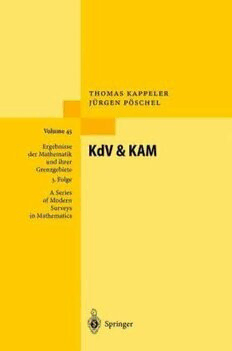
KdV & KAM PDF
Preview KdV & KAM
Version4.6 February2003 NotforCirculation ThomasKappeler Universita¨tZu¨rich,Institutfu¨rMathematik Winterthurerstrasse190,CH-8057Zu¨rich [email protected] Ju¨rgenPo¨schel MathematischesInstitutA,Universita¨tStuttgart Pfaffenwaldring57,D-70569Stuttgart [email protected] Thomas Ju¨rgen Kappeler Po¨schel KdV & KAM Finalstversion(cid:13)c Kappeler&Po¨schel In memory of JU¨RGENMOSER teacher mentor friend Preface Thisbookisconcernedwithtwoaspectsofthetheoryofintegrablepartialdifferential equations. The first aspect is a normal form theory for such equations, which we exemplify by the periodic Korteweg de Vries equation – undoubtedly one of the mostimportantnonlinear,integrablepdes.Thismakesforthe‘KdV’partofthetitle ofthebook. The second aspect is a theory for Hamiltonian perturbations of such pdes. Its prototypeisthesocalledKAMtheory,developedforfinitedimensionalsystemsby Kolmogorov, Arnold and Moser. This makes for the ‘KAM’ part of the title of the book. Tobemorespecific,ourstartingpointistheperiodicKdVequationconsidered as an infinite dimensional, integrable Hamiltonian system admitting a complete set of independent integrals in involution. We show that this leads to a single, global, realanalyticsystemof Birkhoffcoordinates–the cartesian versionofaction-angle coordinates –, such that the KdV Hamiltonian becomes a function of the actions alone. In fact, these coordinates work simultaneously for all Hamiltonians in the KdVhierarchy. While the existence of global Birkhoff coordinates is a special feature of KdV, localBirkhoffcoordinatesmaybeconstructedviaourapproachformanyintegrable pdesanywhereinphasespace.Specificallythisholdstrueforthedefocusingnonlin- earSchro¨dingerequation,forwhichparallelresultsweredevelopedin[51]. The global coordinates make it evident that all solutions of the periodic KdV equation are periodic, quasi-periodic, or almost-periodic in time. It also provides a convenienthandletostudysmallHamiltonianperturbations,byapplyingasuitable generalizationoftheKAMtheorytopartialdifferentialoperators.Tochecktheperti- nentnondegeneracyconditions,weconstructBirkhoffnormalformsuptoordersix togainsufficientcontrolovertheKdVfrequenciesasfunctionsoftheactions.Infact, theseBirkhoffnormalformsarejustthefirsttermsinthepowerseriesexpansionof theKdVHamiltonianinBirkhoffcoordinates. Finally,wedescribethesetup,assumptionsandconclusionsofageneralinfinite dimensional KAM theorem, that is applicable here and goes back to Kuksin. The situationdiffersfrommoreconventionalapplicationsofKAMtopdesinthattheper- X Preface turbationsaregivenbyunboundedoperators.Thisisonlypartiallycompensatedby asmoothingeffectofthesmalldivisors.Inaddition,onehastomodifytheiteration schemeandusenormalformswhichalsodependonangularvariables. Only recently, monographs on KAM theory for integrable pdes appeared, by Bourgain [17], Craig [29], and Kuksin [75]. Of these, the first two choose a dif- ferentapproach,settingupafunctionalequationandapplyingaLyapunov-Schmidt decompositionschemepioneeredbyCraig&Wayne[28].Thelatteremploysanor- malformtheoryforLax-integrablepdesnearfinitedimensionaltori,whichisbased on the Its-Matveev formula. In contrast, the normal form theory presented in this bookwithitsglobalfeaturesgoesmuchfurther.Itallowsustoobtainaperturbation theory for KdV from an abstract KAM theorem of a particularly simple form, and touseBirkhoffnormalformstochecktherelevantnondegeneracyconditions.More- over,thisnormalformmightturnouttobeusefulforotherlongtimestabilityresults forperturbedintegrablepdessuchasNekhoroshevestimates. This book is not only intended for the handful of specialists working at the in- tersection of integrable partial differential equations and Hamiltonian perturbation theory,butalsoresearchersfartherawayfromthesefields.Infact,itisourintention toreachouttograduatestudentsaswell.Itisforthisreasonthatfirstofall,wehave included a chapter on the classical theory, describing the finite dimensional back- groundofintegrableHamiltoniansystemsandtheirperturbationtheoryaccordingto thetheoryinitiatedbyKolmogorov,ArnoldandMoser. Secondly, we made the book self-contained, omitting only those proofs which canbefoundinwellknowntextbooks.Wethereforeincludednumerousappendices –someofthem,wehope,ofindependentinterest–ontopicsfromcomplexanalysis onHilbertspaces,spectraltheoryofSchro¨dingeroperators,Riemannsurfacetheory, representationofholomorphicdifferentials,andcertainaspectsoftheKdVequation suchastheKdVhierarchyandnewformulasfortheKdVfrequencies. Thirdly, we wrote the book in a modular manner, where each of its five main chapters–chaptersIItoVI–aswellasitsappendicesmaybereadindependentlyof eachother.Everychapterhasitsownintroduction,andthenotationisexplained.Asa result,thereissomenaturalrepetitionandoverlapamongthem.Moreover,theresults of these chapters are summarized in the very first chapter, titled “The Beginning”, andheretoowetookthelibertytoquotefromtheintroductionstothelaterchapters. Weconsidertheserepetitionsabenefitforthereaderratherthananuisance,sinceit allowshim,orher,toperusethematerialinanonlinearmanner. Thisbooktookmanyyearstocomplete,andduringthislongtimewebenefitted from discussions and collaborations with many friends and colleagues. We would like to thank all of them, in particular Benoˆıt Gre´bert, with whom we developped parallelresultsforthedefocusingnonlinearSchro¨dingerequationin[51],andJu¨rg Kramer,forhiscontributiontothenondegeneracyresultforthefirstKdVHamilton- ian.MostofallweareindebtedtoJu¨rgenMoser,whoinitiatedthisjointeffortand neverfailedtoencourageusaslongashewasabletodoso.Wededicatethisbook tohim. ThesecondauthoralsogratefullyacknowledgesthehospitalityoftheForschungs- institut at the ETH Zu¨rich and the Institute of Mathematics at the University of Preface XI Zu¨richduringmanyperiodsofourcollaborativeefforts,aswellasthesupportofthe Deutsche Forschungsgemeinschaft, while the first author gratefully acknowledges thesupportoftheSwissNationalScienceFoundatonandoftheEuropeanResearch TrainingNetworkHPRN-CT-1999-00118. FinallywewouldliketothankJulesHobbesforhisnevertiringTEXpertisefrom theveryfirstlinesthroughmany,manyrevisionsuptothefinal,press-readyoutput, andJu¨rgenJostandSpringerVerlagfortheirpleasantcooperationtomakethisbook happen. Last, but not least we thank our families for their patience and support during thesemanyyears. Zu¨rich/Stuttgart February14/16,2003 TK/JP Contents ChapterI TheBeginning 1 Overview 1 ChapterII ClassicalBackground 2 HamiltonianFormalism 19 3 LiouvilleIntegrableSystems 27 4 BirkhoffIntegrableSystems 34 5 KAMTheory 39 ChapterIII BirkhoffCoordinates 6 BackgroundandResults 51 7 Actions 63 8 Angles 69 9 CartesianCoordinates 74 10 OrthogonalityRelations 85 11 TheDiffeomorphismProperty 91 12 TheSymplectomorphismProperty 102 ChapterIV PerturbedKdVEquations 13 TheMainTheorems 111 14 BirkhoffNormalForm 118 15 GlobalCoordinatesandFrequencies 127 16 TheKAMTheorem 133 17 ProofoftheMainTheorems 139 XIV Contents ChapterV TheKAMProof 18 SetUpandSummaryofMainResults 145 19 TheLinearizedEquation 152 20 TheKAMStep 160 21 IterationandConvergence 165 22 TheExcludedSetofParameters 171 ChapterVI Kuksin’sLemma 23 Kuksin’sLemma 177 ChapterVII BackgroundMaterial A Analyticity 187 B Spectra 194 C KdVHierarchy 207 ChapterVIII Psi-FunctionsandFrequencies D ConstructionofthePsi-Functions 211 E ATraceFormula 223 F Frequencies 227 ChapterIX BirkhoffNormalForms G TwoResultsonBirkhoffNormalForms 233 H BirkhoffNormalFormofOrder6 240 I Kramer’sLemma 248 J NondegeneracyoftheSecondKdVHamiltonian 252 ChapterX SomeTechnicalities K SymplecticFormalism 257 L InfiniteProducts 260 M AuxiliaryResults 262 References 267 Index 275 Notations
